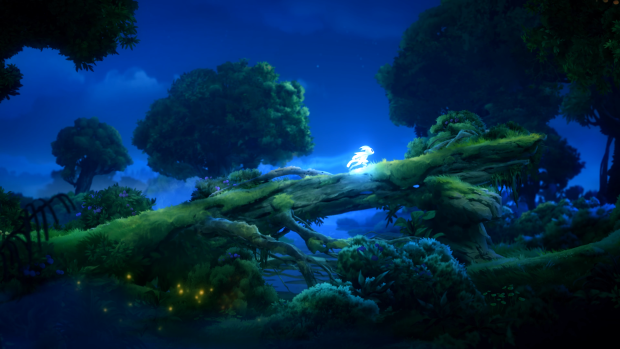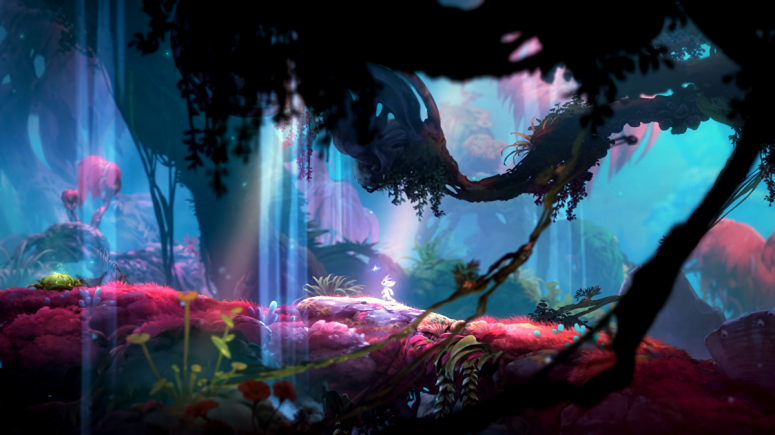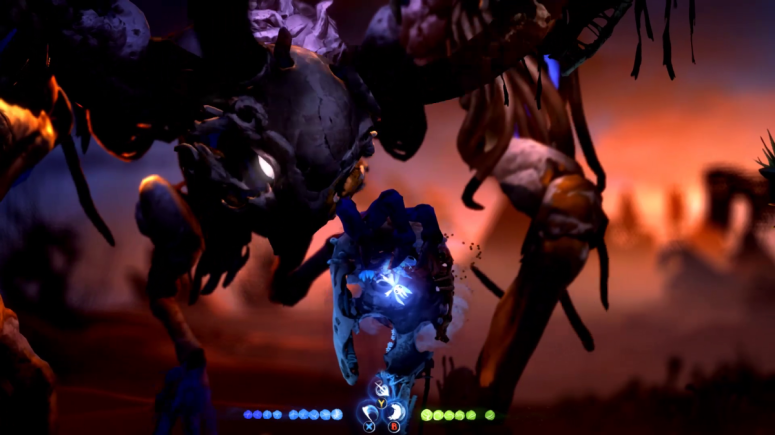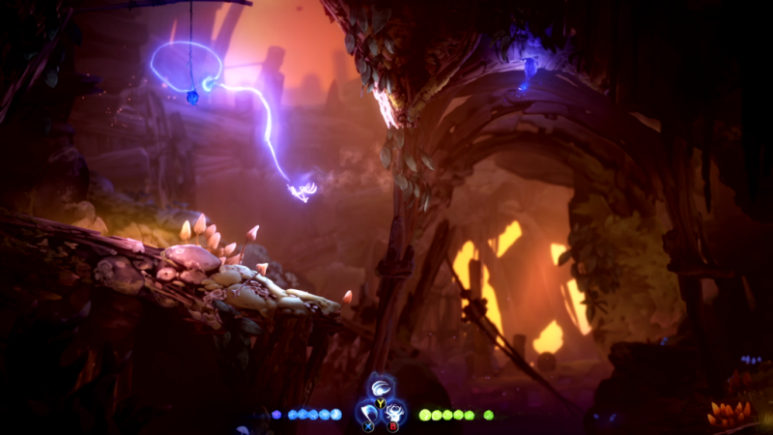Extreme familiarity ends up slightly clouding its advances, and even if the game is still firmly in the upper echelon of its genre due to its beauty, heart, cleverness, and smoothness, its force is somewhat diminished
Originally released in 2015, Ori and the Blind Forest was one among a number of indie titles that ventured into Metroidvania gameplay with the goal of rescuing a genre that was mostly forgotten by the big companies of the market. And from within a large group with individual members that approached the style in a myriad of ways, the adventure put together by Moon Studios and exclusively held by Microsoft succeeded in catching both the eyes and heart of the world quite quickly.
Anyone who goes through that first journey will not have a hard time realizing why it garnered so much praise back when it first emerged. Drawing heavy inspiration from nature and centering around the restoration of corrupted land, Ori and the Blind Forest excels at being beautiful, thereby firmly distancing itself from the genre’s most well-known examples, which tend to thrive in darkness and decay. Meanwhile, in the middle of scenarios of such organic and vivid splendor, which ooze so intensely one can pretty much smell the grass, the main character not only explored an alluring world that unfolded at a gentle pace, but also navigated through it with an acrobatic smoothness that birthed lean clever platforming as well as frantic action detours.

From the get go, Nintendo fans – at least those who did not have the means to play Ori and the Blind Forest – had to look at the game in awe and envy. After all, the quest carries a charm and a family-friendly nature that make it seem like an ideal fit for the platforms and audience of the company; a match made in heaven that appeared impossible thanks to an exclusivity deal. However, five years after the game’s release, the pull of fate proved to be so strong that the gaming universe got weird enough for Nintendo and Microsoft to sign a deal that would bring some of the latter’s games to the Switch, a package that included Ori and the Blind Forest and that, one year later, would also cause its sequel, Ori and the Will of the Wisps, to make the same unlikely jump, albeit much more quickly.
Ori and the Will of the Wisps starts exactly where its prequel left off. After defeating Kuro, the first game’s winged villain, and discovering the uncomfortable reason behind her wrath, her last egg is taken to the protagonist’s house, where it soon hatches. The little owl that comes out of it is given the name of Ku and is treated by Ori and his adopted diverse family as one of them. Born with a damaged wing, the little guy has a lot of trouble learning how to fly, only being able to do so when a feather left behind by his mother is used to patch up the injury.
After slowly gaining confidence in his abilities, Ku and Ori decide to take flight and explore their surroundings. Sadly, though, a vicious storm hits and separates them, with Ori soon learning that his friend happened to land on a cursed piece of forest that was once filled with life but that is now a dusty graveyard guarded by a vicious creature. Rather than being the endgame goal, as it initially seems to be, though, the reunion between friends is merely a prelude, for just as happiness seems to be restored, utter tragedy will strike, and the titular hero will have to – once again – work towards restoring balance to nature in order to undo what was done.
Saying that Ori and the Will of the Wisps is a whole lot like Ori and the Blind Forest may seem like an obvious statement. After all, it is only natural that the sequel to a widely praised game – especially one that found one neat niche in a genre that is now widely populated – borrow a lot of ideas from the one that came before it. But Ori and the Will of the Wisps seems to take it a step further than usual, because it is so aware of the little notes that drove its prequel to stardom that it is quite bent on reproducing them, and nowhere is that more obvious than in its plot’s development.
Case in point, Ori and the Will of the Wisps also opens with fixed gameplay segments that are an interlude between cinematic bits that set up the story; it has a brief introductory sequence that reaches a dramatic climax before the adventure starts for good and the world opens up; it boasts a villain that is a heartless killing machine on the surface but that hides a shocking secret that both makes its fury relatable and works as the quest’s plot twist; and it centers around the relationship between Ori and another character with whom he has familial ties.

That, of course, does not mean Ori and the Will of the Wisps is a failure in plot. Quite contrarily, the effort is actually a miracle in storytelling. Not many are the Metroidvania games that pair up script and gameplay so immaculately, as usually members of the genre either focus on the latter while being minimalistic towards the former or come up with undercooked stories when they aim for having a meaningful script. Ori and the Will of the Wisps does not fall into that trap, since it clearly goes for significant plot and comes out of that endeavor with a tale that is strongly touching, being augmented by splendorous animations and a movie-worthy orchestrated soundtrack. It has, however, to be pointed out that its emotional weight may look familiar or calculated to those who have gone through the prequel.
As for its gameplay, Ori and the Will of the Wisps, despite obviously firmly following on the footsteps of its predecessor, does an arguably better job when it comes to creating some comfortable separation. Even if it qualifies as a Metroidvania and packs one large world of interconnected environments with plenty of branching paths and secrets, the game takes a more accessible approach to it than the likes of Hollow Knight, for instance, an effort that finds its challenge and beauty in opening its world quite widely and quite quickly and then leaving players to figure it all out for themselves.
When it begins, Ori and the Will of the Wisps is pretty linear, as the hero will need to find a way to the desolate region where his poor friend happened to land. Once that objective is cleared, though, Ori will be tasked with recovering four wisps, the friendly spirits that will help him restore the forest to its former glory, and on what is a visible improvement in terms of progression when compared with the original game, here the first three of those beings can be recovered in whatever order players want to. Such a turn has two immediate positive effects: firstly, it gives players the chance to choose their own path through the adventure; secondly, it means that, right from the start, the world is more open than that of its predecessor, with more areas being reachable at pretty much any point in the quest.
Ori and the Will of the Wisps, however, will never leave players totally blind. It will, instead, find a nice balance between giving directions and keeping its mysteries. When they become the goal, the resting locations of the wisps will be marked on the map. Yet, being in regions still unexplored, they will just be shiny dots in the midst of the blackness of uncharted territory, giving one – consequently – a mere general orientation regarding which way to go. The task of figuring out how to get there will be up to gamers, and the journey is undeniably rather nice.
Instead of forcing players to backtrack to previously explored areas so they can use their newly found abilities to enter new sub-sections of the place (a job that is quite common in the more complex examples of the genre, like Hollow Knight itself and Super Metroid), Ori and the Will of the Wisps – like its prequel – takes a simpler approach to those matters. The regions where the wisps are happen to be somewhat self-contained, even if they are naturally connected to the rest of the world; as such, if one has no interest in optional collectibles, all they need to do is get into those areas, overcome the challenges that lie inside, and walk away with yet another forest spirit in their pocket so they can move on to the next objective and never look back. This simplified description is, however, not quite worthy of how greatly designed that process is.

The areas where the wisps rest can be somewhat compared to the dungeons of a The Legend of Zelda game, if they were transported to a sidescrolling perspective and Link became a tiny flexible forest spirit with ridiculous acrobatic skills. During their first half, Ori will solve puzzles and overcome platforming challenges centered around a theme: in the coldness of Baur’s Reach, for instance, he will have to find a way to light fires that will open the path forward, whilst in the darkness of the Mouldwood Depths, he will have to avoid staying too long in the pitch black areas as to get away from the sharp teeth that lurk in the gloom.
Midway through them, as it happens in the mazes of Link’s adventures, Ori will acquire a new skill, and that ability will alter the way with which he can interact with the world and, naturally, allow him to get to places of the region that were far from reach. In the sandy Midnight Burrows, his trick will be digging through dirt like a speedy drill, while in the lush Luma Pools, the hero will be able to pop out of the water in the same way a jumping dolphin does, letting him reach some impressive heights.
Finally and unsurprisingly, the roads to the wisps are ultimately blocked by either fearsome bosses or, borrowing a page from Ori and the Blind Forest, thrilling escape sequences. The first are mostly great in spite of being a tad too easy; the second, meanwhile, falter because though adrenaline-inducing and visually spectacular, they do have the problem of forcing players to restart from scratch in case they die – a twist that can be painful considering how some of the dynamic obstacles of those chases border on being too fast for one to successfully react on a first attempt.
In the end, the setup of these individual areas definitely works. Those who feel overwhelmed by the Metroidvania games that lean towards complexity will be pleased that most of their search and path-finding will be limited to self-contained areas rather than a gigantic world. Meanwhile, those who like a more expansive challenge will be feeling too much awe stemming from the puzzles and platforming to stop and think about the fact Ori and the Will of the Wisps is a member of the genre that, despite the pleasantly big size of its map, tackles it in small chunks.
What is most impressive about Ori and the Will of the Wisps is that the protagonist does not really have any game-defining skills. His abilities are, for the most part, pretty mundane inside a sidescrolling universe. There is nothing special about double jumping, dashing, climbing walls, digging through dirt, swimming like a bullet, using a feather to glide, grappling towards specific surfaces, or bursting through the air. In fact, Ori’s sole original (and very much excellent) skill is probably using enemies and projectiles to catapult himself in any desired direction, which opens up quite a bunch of possibilities. Yet, with those basic tools, the game squeezes a lot of sparkling segments out of its platforming and puzzles.

When it comes to the first, much of its quality is related to how seamlessly Ori moves and how beautifully his skills can be combined, as one can be forced by the game to – for instance – burst out of the water, stick to a wall, and execute a double jump from there while timing it perfectly with a projectile so it can be used as a catapult to let Ori fly higher and grapple towards some blue moss. Chaining moves like this is accessible to all and everyone thanks to the title’s pleasantly floaty physics, which make the hero quite malleable away from the ground and give players some time to think about their next action. It is airborne ballet by a glowing forest spirit in the middle of layered natural scenarios that are a sight to behold.
As for the puzzles, in true The Legend of Zelda and Metroid Prime fashion, not only are they inventive in nature, thanks to the various gadgets and obstacles the game boasts, but they can also be quite wide, occasionally pushing gamers to combine various elements of the environment so they can escape some tight spots.
Complementing those two veins, Ori and the Will of the Wisps also has a decent combat component. Overall, battles are really not special enough to write home about, as enemy variety is not too big and a considerable portion of them can be disposed of by good old button mashing. It is, however, worth noting that the game gives players plenty of ways to attack. As the quest goes on, Ori will – be it by purchase or by tracking down ancestral trees – come across skills that are quite varied, such as a bow and arrow of light, a boomerang-like star, a sword, a spear, a fire attack, and a few others.
Although flexible, it is a collection of moves that could have been better explored if there were foes that required a specific skill to be used. Furthermore, given they must be assigned to one of three buttons – which also happen to be the slots where a few mandatory abilities, such as making Ori into a projectile or using the feather to create a gust of wind, have to be put – it is also easy to wish the game would have made more buttons available as customizable slots. Still, it is hard to deny the battles are good fast-paced fun.
To top it all off, Ori and the Will of the Wisps also holds a good deal of extra content to possibly boost its ten-hour adventure to an even meatier length. There are energy cells and life cells, which respectively increase the character’s health and magic powers. There are a few optional skills. There are thirty-two spirit shards, items with passive effects (like giving Ori a triple jump or boosting the damage he deals when more than half of his energy gauge is filled) that can be equipped into a limited number of slots. There are pieces of ore and seeds, which can be used to little by little reconstruct a cozy living space for forest creatures. And there are even some side-quests, a few combat challenges, and a handful of races.
To a point, it is true that some of these additional elements can be criticized. Making sure to collect a lot of energy and life cells is not too critical because in its easy and normal difficulties Ori and the Blind Forest is never really challenging; and, in a way, the same applies regarding the need to find a good combination of spirit shards to equip. Moreover, the side-quests could have been more numerous, as they are so scarce they can at times feel like a feature that was put into the game but not completely developed. Nevertheless, there is so much charm to the quest and it is so fun to uncover all of its secret corners that players will likely feel compelled to tackle full completion regardless of how useful or fully realized the extra content is.

Many of the shortcomings displayed by Ori and the Will of the Wisps can be traced back to its predecessor. Much like its successes, the game’s little failures come from the fact it has naturally inherited a good slice of the soul of its progenitor. However, given that connection is, especially in the storyline department, a little too close to comfort, this second effort by Moon Studios does not generate the same level of impact delivered by its prequel.
It is not that Ori and the Will of the Wisps is devoid of improvements. In fact, the additional degree of freedom given to players thanks to its looser structure goes a long way towards making its adventure more enjoyable, and other marginal tweaks also make it display solid evolution. But the bottom line is that extreme familiarity ends up slightly clouding those advances, and even if the game is still firmly in the upper echelon of its genre due to its beauty, heart, cleverness, and smoothness, its force is somewhat diminished.

Loved this review, and really makes me want to buy the game and play it now!
Thanks a lot! I am glad you loved it. And if you do go out and get the game, I hope you enjoy it as much as I did.
Definitely been added to my bucket list, a list that doesn’t stop growing haha
In a way, that’s a good thing. Running out of stuff to play is never fun.
As we all know, 8/10 is 0/10 in internet world. So a flame war is coming”
! (not the “)
Now I am curious. Do you have strong feelings regarding this game? Or is it your standard procedure to declare a flame war whenever a big game gets an 8? =P
It’s standard procedure for me to declare war about everything. I am, after all, a professional moron!
Fair enough.
I loved this game so much, but it ended up glitching out on me SO many times. It was quite the abusive relationship.
Oh yeah, there are quite a few glitches left in there, at least on the Switch version. It happened to me as well. The game crashed at least half a dozen times. Fortunately, I never lost any progress.
I had game-breaking, nay, CONSOLE-breaking glitches. It was totally disheartening. Especially because I could see how exemplary the game was through all the crashes.
Wow, I am sorry to hear that. Were you playing it on the Switch?
No, on an Xbox One S.
It seems the glitches are everywhere then. I thought they were concentrated on the Switch.